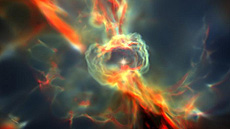Bringing the universe into full focus
 |
From supernova explosions to writhing tendrils of dark matter, visualizations give new life to models and theories. Image courtesy of Ralf Kaehler and Tom Abel (visualization); John Wise and Tom Abel (numeric simulation)
|
In a darkened barn in Sweden in 1941, astronomer Erik Holmberg constructed two identical sets of 37 light bulbs, arranged in rings, to study the effects of a close encounter by two passing galaxies.
Using a light sensor connected to a device that measured electric current, Holmberg carefully charted, by hand, gravitational effects in energy signatures as he moved the two sets of bulbs closer together, and noted the emergence of "spiral arm" patterns.
He correctly concluded that galaxies can cluster and merge together as a result of such close passages. The experiment demonstrated the power of simulations and visualizations in understanding complex astrophysical phenomena, even before the era of computing.
Flash forward more than 70 years, and Holmberg's light bulb galaxies spring to life in three-dimensional visualizations made possible by advances in programming, computing power, observational data, theory and a smattering of graphical artistry.
In a windowless room at the Kavli Institute for Particle Astrophysics and Cosmology, visitors wearing 3D glasses witness the grand gravitational interplay of two large galaxies passing in close proximity, their spiral arms swinging out like choreographed combatants. Then the galaxies collide in a burst of light, with the scattered bits circling back and joining a new, larger galaxy. The two-minute, highly detailed visualization encapsulates 2 billion years, incorporates 40 million particles, and plays out on a 123-inch screen, offering an immersive and interactive way to dial back the universe's clock and refine calculations about its progression by comparing the visualization with observations.
The film includes about 40,000 separate "time steps," strung together into a movie, and required the equivalent of about 200,000 computer processor hours—a measure of the amount of time it would take a single processor to complete the visualization—to complete.
Read more
—Glenn Roberts Jr.
|